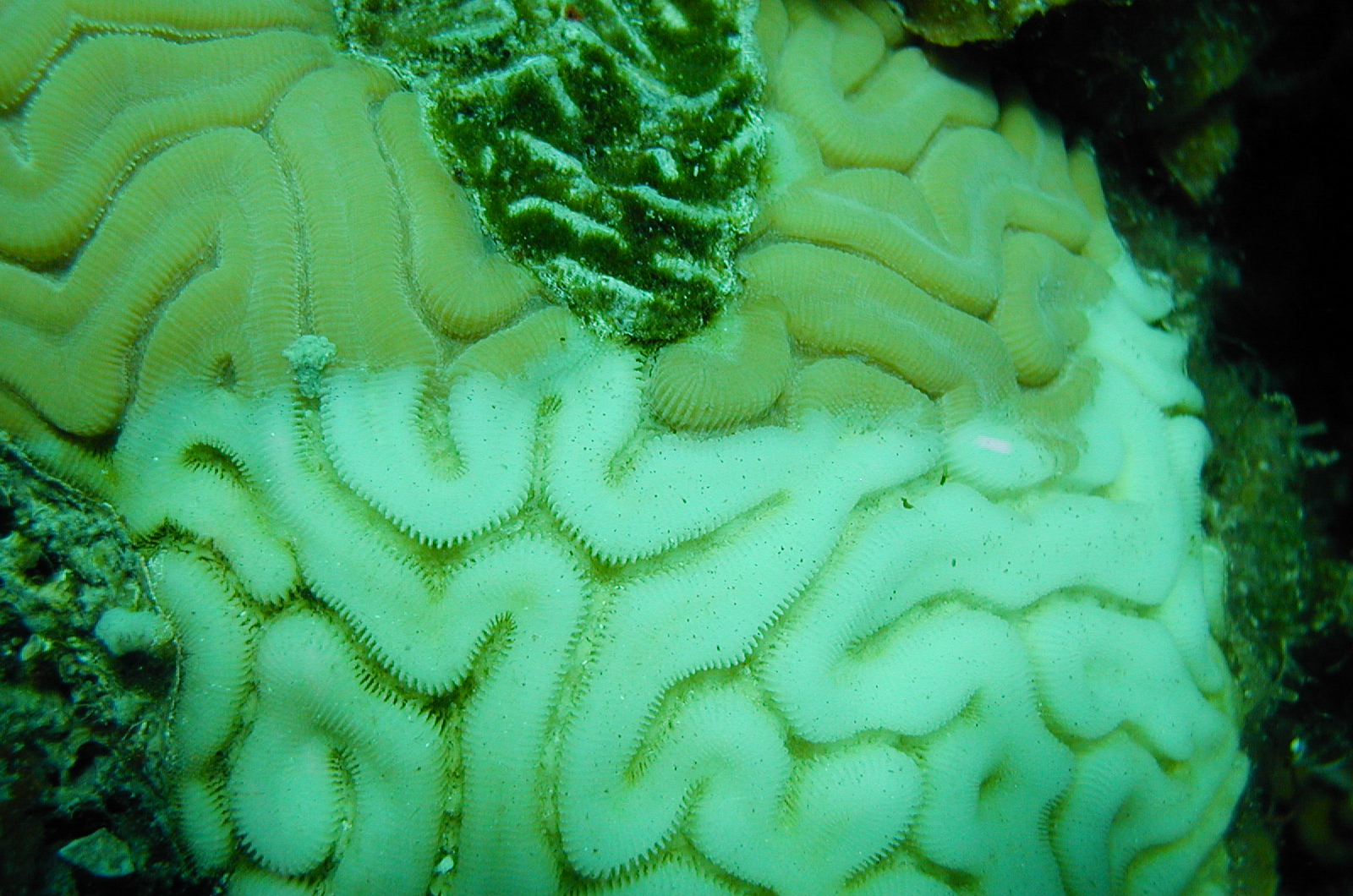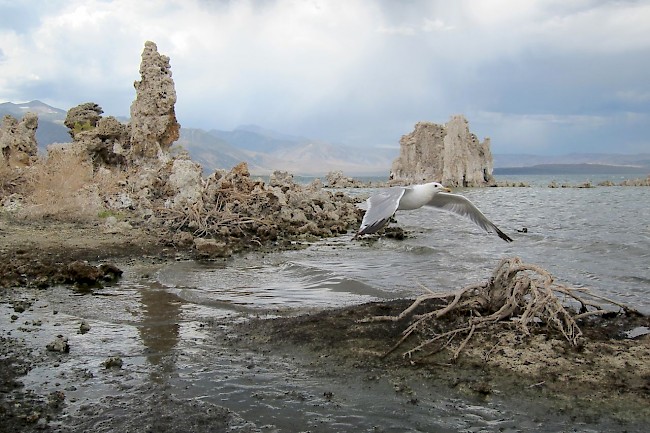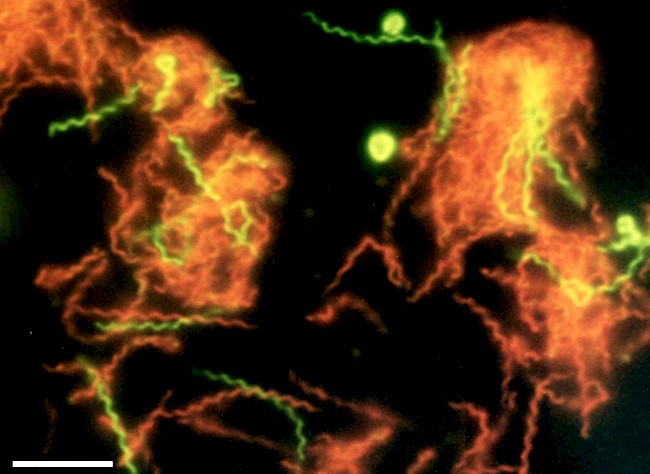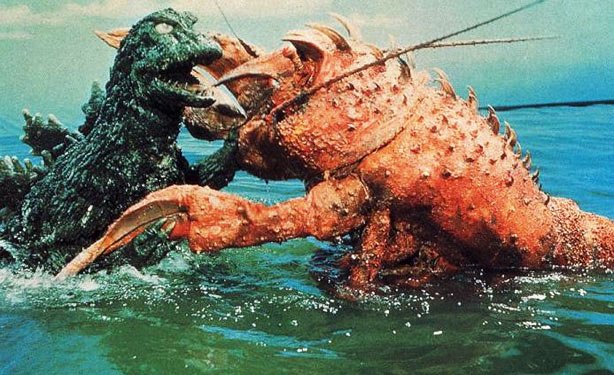— Arsenic Dreams

In 2010, a group of scientists working for NASA announced a startling discovery. They claimed to have found a strain of microbes, hidden in the depths of Mono Lake in California, that were able to consume arsenic as a replacement for phosphorus. This was a surprise. Phosphorus is one of the basic, necessary building blocks of life alongside carbon, oxygen, hydrogen, nitrogen, and sulfur. Arsenic, on the other hand, is generally toxic: not just to human beings—for whom it has a long history of being used as a poison—but to all known living entities.
Arsenic is located just below phosphorus in the periodic table; the two elements share many of the same chemical properties. This is why arsenic is so deadly. Phosphorus is crucial to the molecular structure of DNA; it is also a key component of ATP (adenosine triphosphate), which living cells use to store energy. When arsenic enters into a cell, it commandeers the same chemical slots that are usually occupied by phosphorus. The results are fatal. ATP stops functioning, so the organism is no longer able to consume energy. DNA is put under stress, and becomes subject to carcinogenic mutation.
The waters of Mono Lake are rich in arsenic and poor in phosphorus. The NASA scientists claimed that GFAJ-1 bacteria, which they discovered living in the depths of the lake, had evolved the ability to use arsenic atoms in their DNA as a functional replacement for phosphorus, when the latter was unavailable. The discovery seemed to rewrite and expand the rules of life, allowing for entirely new versions of basic biochemical processes. GFAJ-1 was not actually extraterrestrial life, but it provided a clue for how such life might be able to develop under ecological conditions far different from the ones we know on Earth. No wonder NASA bankrolled this research.
Alas, the NASA scientists’ claims were soon debunked. The researchers had not actually examined GFAJ-1’s DNA; they had simply succeeded in growing the bacteria in the laboratory, in arsenic-heavy and (as they mistakenly thought) phosphorus-free conditions. But when other scientists analyzed the DNA from GFAJ-1, they found that it was phosphorus based, just like that of all other known organisms. Meanwhile, further tests showed that the bacteria were in fact still able to obtain at least some phosphorus from their lake environment, and that phosphorus had not been altogether absent even from the laboratory studies.
This does not mean that the original research was worthless. The NASA scientists had in fact discovered something quite interesting—but which contradicted their initial hypothesis. GFAJ-1 bacteria, it turns out, have a far greater degree of resistance to arsenic poisoning than other organisms. Far from being able to use arsenic atoms in their metabolism, they have evolved a mechanism to block these atoms from interfering with the ordinary life processes of the cell. As an adaptation to living in high-arsenic surroundings, they have found a way to sequester the arsenic where it will not harm them. GFAJ-1 provides no clues to extraterrestrial life, but it might help us deal with environmental degradation and toxic pollution.

The story of the allegedly arsenic-loving bacteria exemplifies the way that science is supposed to work. Scientists discover a phenomenon that does not fit into previously accepted paradigms. They construct a hypothesis that might help to explain the new phenomenon. The hypothesis becomes, in its own turn, a basis for further testing. This new experimentation produces results that either support the initial hypothesis, or discredit it. But the latter outcome should not be considered a failure. In both cases, we learn something new about the world, and we open up new directions for further research.
Part of the point here is that science is much more than just a passive process of discovery, or a compiling of facts that are simply “out there.” Rather, science must actively approach things and processes in the world. It must solicit and elicit phenomena that would not disclose themselves to us otherwise. It must somehow compel these phenomena to respond to our questions, by giving us full and consistent answers. All this is necessary, precisely because things in the world are not cut to our measure. They have no reason to conform to our presuppositions, or to fit into any categories that we seek to impose.
The modern empirical scientific method is sometimes described as a process of “torturing nature to reveal her secrets”—a phrase often wrongly attributed to Francis Bacon. But a much better account is the one proposed by Bruno Latour and Isabelle Stengers, who say that scientists work by negotiating with nonhuman entities, and by entering into alliances with them. Scientists do not get very far by treating the things they are interested in as mute and inert objects to be dissected. They do much better when they are somehow able to collaborate with the very entities that they seek to observe and explain.
Alfred North Whitehead, a major inspiration for both Latour and Stengers, notes that if the “rigid … Baconian method of induction” had been “consistently pursued,” it “would have left science where it found it.” Nothing new would ever have been discovered. Whitehead insists that science needs not just empirical observation and induction, but also “the play of a free imagination, controlled by the requirements of coherence and logic.” That is to say, a certain degree of speculation is always necessary in scientific research. This speculation has to be “controlled” in some manner; it cannot be altogether arbitrary and unbounded. But without speculation, science is caught in a rut. It cannot stretch beyond the given, immediate facts in order to provide a plausible explanation for these facts.
The speculative process described by Whitehead is roughly similar to what Charles Sanders Peirce calls “abduction.” For Peirce, abduction stands in contrast to—and supplements—both deduction and induction. Deduction starts with conditions that are already given, and traces out a chain of logical consequences for those conditions. Induction, for its part, generalizes on the basis of an already given set of particular observations. According to Peirce, neither deduction nor induction can actually suggest anything new. Abduction, in contrast, makes a sort of leap into novelty. It shifts registers, suggesting a higher-order explanation for the circumstances with which it is concerned. The NASA scientists were working by abduction when they proposed that GFAJ-1 bacteria were able to survive in Mono Lake because they had found a way to substitute arsenic for phosphorus. In this particular instance, the scientists turned out to be wrong. But the greater lesson here is that we can never dispense with abduction or speculation. Science is often praised for having—as other human disciplines do not—an intrinsic self-correcting mechanism. But without engaging in abduction or speculation, science would not have anything to self-correct in the first place.

Because it requires flights of speculation, as well as collaboration among many separate entities, science can never be purely human, nor purely rational. This is why efforts to place science on a pedestal, radically separating it from other forms of thought and endeavor, are so deeply mistaken. Philosophers like Wilfrid Sellars, Robert Brandom, and Ray Brassier have sought to radically distinguish the sapience involved in rational truth procedures from what Brandom scornfully dismisses as “mere animal sentience.” But in fact empirical science and rational discourse are largely continuous with other ways of feeling, understanding, and engaging with the world. These would include art, myth, religion, and narrative, together with nonhuman modes of inference exhibited by other sorts of organisms.
In particular, we should be alert to the deep animal roots of scientific experimentation and discovery. As the biologist Bjorn Brembs points out, there has recently been a major paradigm shift in neuroscience: a “dramatic shift in perspectives from input/output to output/input.”1See → We can no longer be satisfied with the old stimulus/response model, according to which animals just passively respond to prior, incoming stimuli. Rather, it has become clear that animals are active reality-testers. They engage in forms of spontaneous behavior, in order to probe their environment in various ways. And they subsequently modify their own behavior on the basis of the feedback that they receive from their environment.

In other words, we cannot explain how animals behave without attributing inner mental states to them. Even such animals as fruit flies (the focus of Brembs’s own research), which only have tiny brains, actively compare the actual results of their reality-testing with what can only be called their prior expectations. That is to say, animals are continually engaged, in their own particular ways, in processes of speculative extrapolation and experimentation. When scientists perform experiments and develop theories, actively soliciting responses from the world, they are fundamentally doing the same thing as these fruit flies—albeit in a far more sophisticated manner, and on a higher and more reflexive metalevel.
Among human beings, speculative extrapolation is not only the method of science. It is also what art in general does—and what science fiction does in particular. Joan Slonczewski is both an eminent microbiologist and an accomplished writer of science fiction. Her novel Brain Plague was published in 2000, well before the discovery of GFAJ-1 bacteria in Mono Lake. But Brain Plague already envisions microbes that use arsenic instead of phosphorus. In the novel, these bacteria evolved on another planet, one that is much richer in arsenic than our own. They also exhibit human-level intelligence; in essence, each individual microbe is a biological nanocomputer. The microbes’ thought processes are mediated by chemical reactions not all that different from those of our own neurotransmitters.
Brain Plague focuses on the uneasy relationships between human beings and these tiny arsenic-based life-forms. The microbes have migrated from their home planet and taken up a new lifestyle as human commensals. They inhabit, and populate, the subarachnoid space on the periphery of the human brain. The microbes have their own sociopolitical institutions and arrangements; they are also able to communicate linguistically with their human hosts. The relations between the two species range from full-fledged symbiosis to outright parasitism. Some microbial communities revere their human hosts as gods, praying to them for boons and obeying all their commands. Others enslave their human hosts, manipulating their behavior with carefully modulated synaptic releases of dopamine. In between these extremes, there are various degrees of collaboration and conflict. At best, the microbes operate as “brain enhancers,” radically boosting the creativity and intelligence of their human hosts in return for protection and nourishment.
Just as transactions between human beings are mediated by money, so all transactions among the microbes, and between them and their human hosts, are mediated by arsenic. This is because arsenic is the one element that is absolutely necessary to the microbes’ survival, but that they cannot scavenge directly from the human brains they inhabit. Human hosts reward their microbes for obedience and help by providing them with frequent arsenic snacks. At the other extreme, enslaved human beings are basically junkies, sacrificing everything else in order to score arsenic hits for their ever-more-voracious parasites.
Slonczewski’s speculative fiction thus envisions a world in which arsenic-based microbial life not only exists, but actually has a meaningful role to play. This vision is not a utopian one. Many things go wrong in the course of the fluctuating relations between human beings and microbes, and these are described in the novel in graphic detail. Nonetheless, there is a lesson to be learned here. Even so dangerous a poison as arsenic can have a positive role to play in the larger environment. Every bioenergetic process generates its share of potentially toxic wastes. But one organism’s waste often serves as another’s food. And this overall terrestrial cycle of far-from-equilibrium energy transfers is ultimately fueled by the Sun (and, in science fiction, by other stars as well). In this sense, even the Anthropocene—the era of human-generated climate change—isn’t only about us. It also involves the enormous number of nonhuman actors, both living and nonliving, with whom we share our lives. A robust practice of speculative extrapolation, in the forms both of science and of art, remains crucial if we are to negotiate our relations with all these other actors, rather than dragging them along with us into some “mutual ruin of the contending parties.”
×


